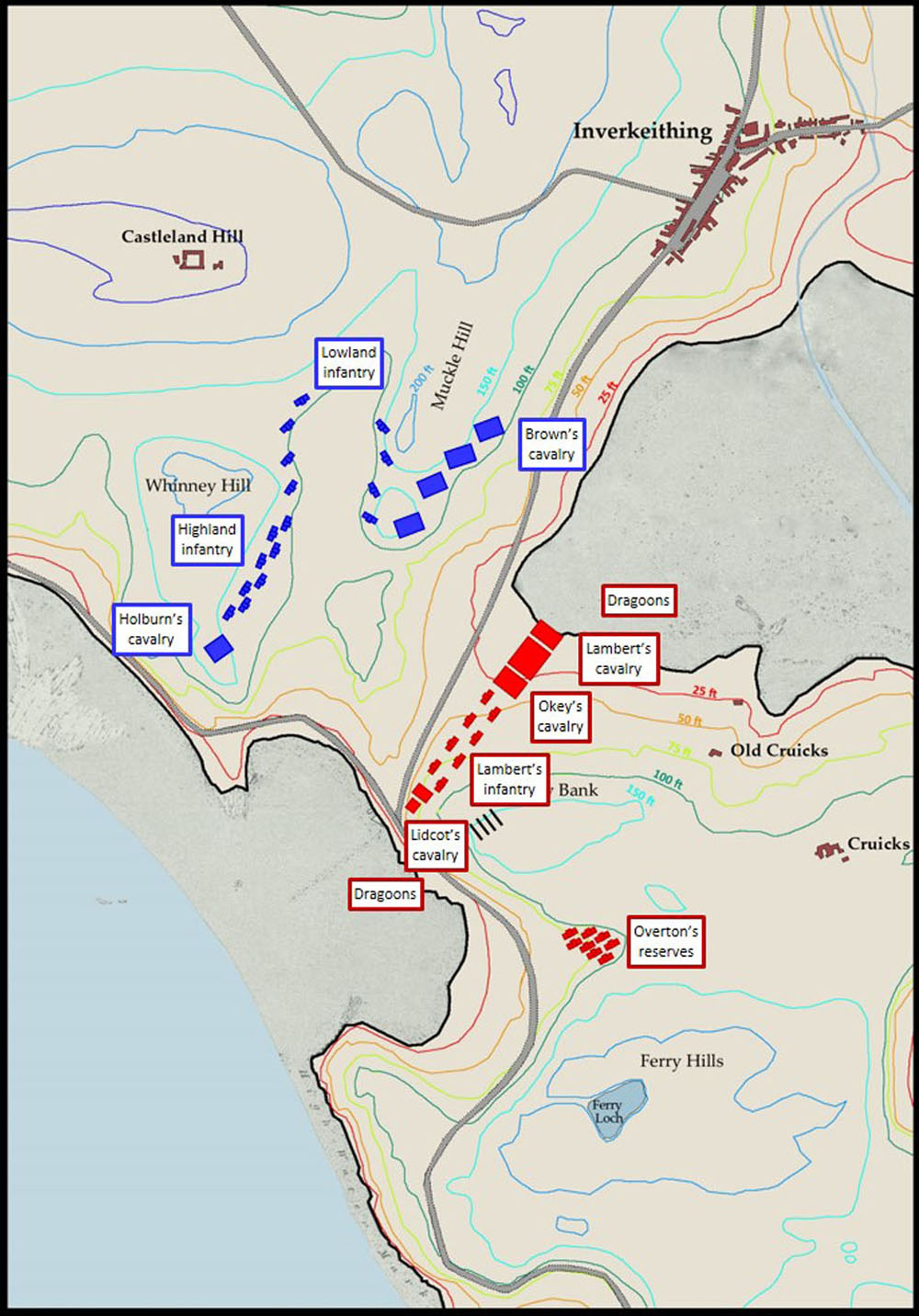Head to head confrontation
| < The Scots respond to the landing | Δ Index | Battle Begins > |

In response to the approaching threat, Lambert’s had deployed his forces in their standard cavalry – infantry – cavalry formation across the neck of the peninsula – he had his strongest cavalry force under Col Lidcot on his right, with half his infantry in the centre and a smaller force of cavalry under Col Okey on his left wing. The other half of his infantry was held in reserve, hidden in the hollow of Gallow Bank, and led by Col Overton.
As the Scots Army marched from Inverkeiting, Lambert rode out with a few of his cavalry to draw the Scots forward – perhaps hoping that they would be fooled into attacking an apparently smaller invading force.
But Leslie was cautious and wheeled his men away north, to take advantage of the three hills which faced Lambert’s position – Whinney Hill, Castleland Hill and Muckle Hill.
Holburn positioned his troops in standard formation, mirroring Lambert’s deployment. He placed his own regiment of cavalry on his right wing on the slopes of Castland Hill (looking north today it is crowned with radio masts) flanking the Highland infantry.
Brown took command of several other cavalry regiments over on Muckle Hill (topped with houses today.) The Lowland infantry lined a pass between these hills (the path of the motorway north today) with musketeers to prevent an English breakout from the peninsula.
The Scots were probably deployed as follows:
Right – Whinney Hill
• Brown– cavalry – 600.
Centre – Castland Hill
• Holbourne’s Lowland infantry – 2200.
• Maclean & Buchanan Highland infantry on Holbourne’s right – 1,500?
• Barclay’s musketeers in a pass in front of Holbourne’s right
Left – Muckle Hill
• Brechin – cavalry – 150.
• Augustine – moss-troopers – 200.
The Highland regiments had only recently arrived at Stirling; they may well have been itching for a fight, but unlike the Lowlanders had not yet encountered Cromwell’s army.
Opposing them were Lambert’s forces:
Lambert placed his strongest cavalry force under Col Okey on his right, half his infantry in the centre and a smaller force of cavalry under Col Lidcot on his left wing. They were squeezed into a very narrow front across the isthmus The other half of his infantry, led by Col Overton, was held in reserve, completely hidden in the Welldean valley behind Gallow Bank.
• Right Wing: cavalry and dragoons
Lambert’s own regiment of cavalry – 500;
plus Col Okey commanding
two Troops from Col. Lidcot’s – 200 dragoons
and two from Col. Okey’s – 160 cavalry
A total of 860 = 660 cavalry plus 200 dragoons
• Left Wing: cavalry and dragoons
Col Lidcot in command
four troops of Col Okey’s – 320 cavalry
two troops of Col Lidcot – 200 dragoons
A total 520 = 320 cavalry and 200 dragoons
• Centre – Infantry:
Col Lambert’s infantry regiment – possibly 800 men
Col Daniel’s infantry regiment – possibly 1000 men.
• Reserve infantry, hidden in Gallow Bank:
Col Overton in charge
Col West’s regiment – possibly 800 men.
Col Silers’ regiment – 1,000 men
As the Scots infantry moved into position, they were harried by some of Okey’s cavalry before Lambert and Okey fell back to their own lines.
The two armies settled in to observe each other’s strengths and weaknesses. Neither side had a decisive weight of numbers, they were each waiting or hoping for further reinforcements. The Scots only had to keep Lambert’s force bottled up, while Lambert had to break out of the peninsula.
Lambert started the campaign with the captured guns on Gallow Bank which began a murderous sweep across the opposing forces, causing many casualties in the Highland regiments. He hoped to reduce the strength of his opponents while waiting for news of further reinforcements from across the river.
Time marched on with neither side ready to launch an all-out attack.
| < The Scots respond to the landing | Δ Index | Battle Begins > |